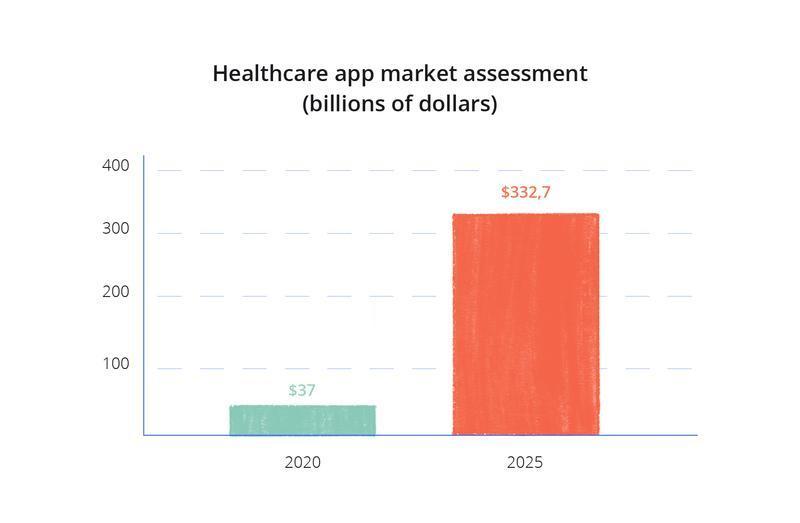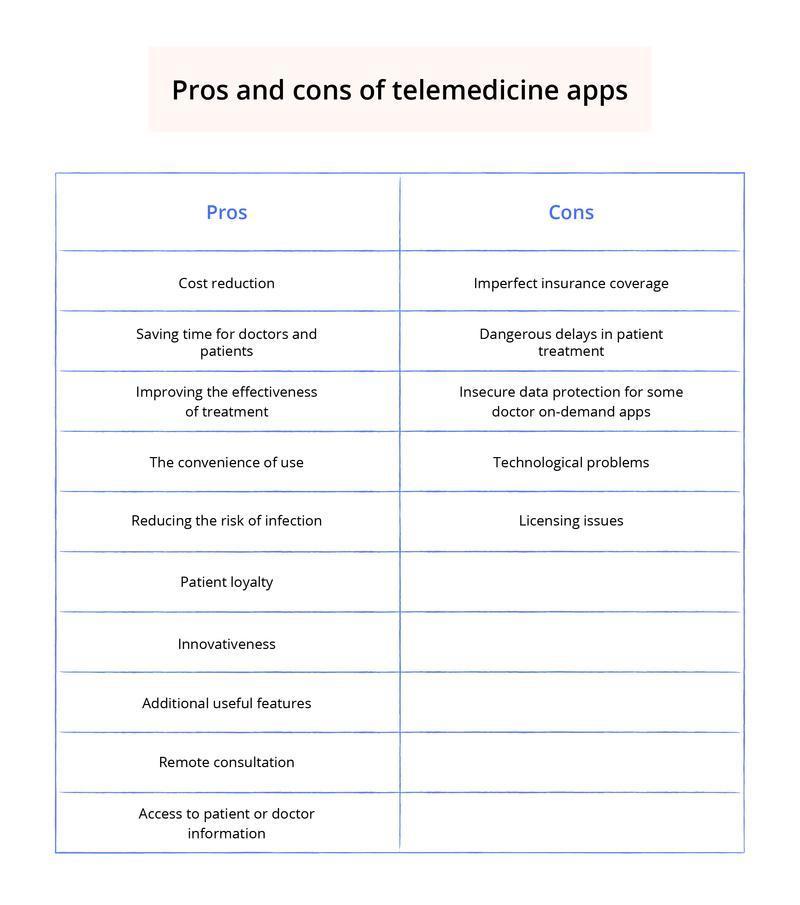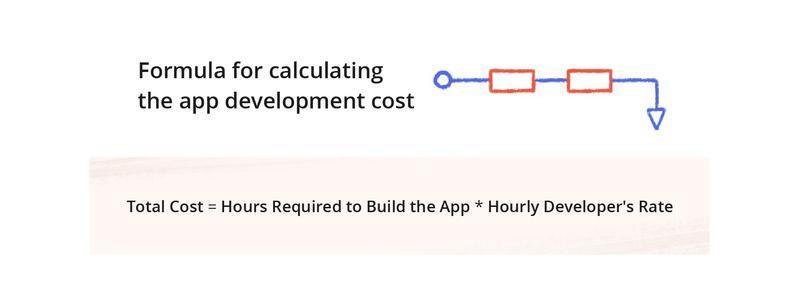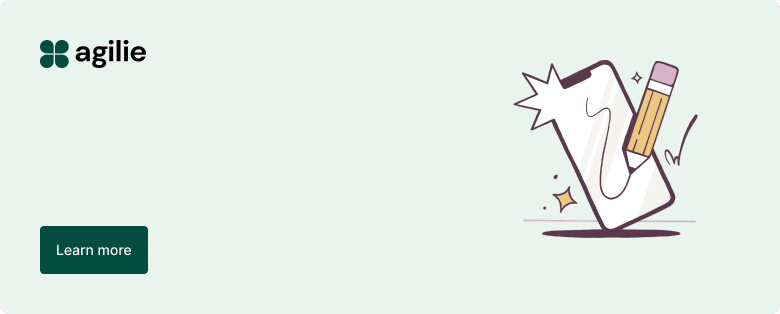Online communications of all sorts have become part of our lives when COVID-19 left us no choice but to engage the mode of remote interaction with both people and organizations. This especially affected such areas as healthcare and the purchase of foodstuffs and essential commodities (including medicines).
Indeed, nowadays, no one wants to go to a hospital or drugstore, unless there is a good reason; most of us prefer online consultations and remote ordering of medicines. That's why healthcare on-demand apps, as well as prescription delivery applications, are so popular right now.
But here's the paradox: the supply hasn't met the sudden increase in demand yet! As the analysis shows, there are still very few mHealth programs on the market. Therefore, it’s worth taking the opportunity and starting a business. And we’ll help you with our tips and, if necessary, practical assistance. Interested? Then read our article on how to develop a pediatrics on-demand app.
Of course, the development topic is too complicated, so, as always, we'll start our discussion from the very basics, at square one.
Hiring professional mobile app development services is important when developing efficient and efficient on-demand pediatric applications.
What is a pediatrics on-demand app?
Essentially, this is a platform that connects patients and doctors. And although we're talking about on-demand pediatrics apps in our article, in fact, such programs can cover various healthcare experts, not just pediatricians. It all depends on the task at hand.
These mobile services are also called telemedicine apps. They allow doctors to virtually examine their patients, as well as diagnose and treat them. And it works, even with serious illnesses.
A meta-analysis of the use of telemedicine for the treatment of chronic heart failure, conducted several years ago, proves the effectiveness of digital medicine. The experts concluded that the assistance of telehealth programs led to lower hospitalization rates, shortened hospital stays, and reduced the number of fatal outcomes. Impressive, isn't it?
But before you finally decide to develop a telemedicine and telehealth app, let's figure out if such a service is really needed. And if so, who would make use of it and when.
Latest stats on dr on-demand apps
Even in the pre-coronavirus era, 40% of doctors believed that the popularization of telemedicine apps would reduce the need for patient visits. However, these programs remained in little demand anyway (only 11% of people used them regularly). The pandemic has forced us to rethink our outlook on life, and now more than 75% of the world's population takes advantage of mobile applications to get healthcare services online (whenever possible).
Moreover, according to analysts' reports, such a trend is likely to increase its influence on our society. And the global mHealth app development market is predicted to grow 9 times since 2020 to reach $ 332.7 billion by 2025.

The conclusion is simple: do your utmost to occupy a free niche before there is too much competition. After all, only the best doctors and pediatrics on-demand apps would get a real chance to become true market leaders and attract a maximum of users.
How does an on-demand doctor app work?
As we said, with the help of these apps, you’re able to consult with pediatricians (or other doctors) online via chat or video link. The main thing is you have access to the service 24 hours a day, 7 days a week. Of course, features of an on-demand doctor’s application aren't limited to just online communication with physicians; however, we'll discuss the functionality issue later.
Doctors should use dr on-demand apps if they want to:
-
automatically collect information about the health status of people;
-
conduct remote consultation and diagnosis of patients;
-
assess whether the patient needs a personal visit to the hospital;
-
provide certain types of medical care;
-
write prescriptions for medicines. By the way, the best on-demand doctor apps also allow users to order and deliver the prescribed drug.
-
conduct online monitoring of the patient's condition.

Telehealth apps are especially useful in situations where the patient needs to be physically distanced and therefore cannot visit the medical facility in person.
Pros and cons of telemedicine apps
Now let's do a comparative analysis of the key advantages and disadvantages of telehealth apps. Because they have their undoubted pros and, alas, a few cons.
Pros
We'd like to start with an upbeat list of the main app pros. That is, who (and how) benefits from the pediatrics on-demand app?
The patients
Telemedicine can help treat a lot of diseases and is most successful when the patient describes his symptoms as accurately as possible.
Other benefits of patient’s apps include:
-
Reduced costs. Any disease is cheaper to prevent than to cure. And the continued use of on-demand med apps allows patients to stay healthy and spend less time in the hospital, which results in significant cost savings. Besides, online consultations with doctors require no road expenses (gasoline is rather expensive today).
-
Disease prevention. Being able to prevent disease is good in itself and not only in terms of cost savings (naturally!).
-
The convenience. These applications provide people with day-and-night access to healthcare, anytime and anywhere. You don't need to take time off from work or hire a nanny to look after your child. In addition, you have a chance to make an appointment with a doctor online, which means you should forget about long queues.
-
Safety. Also, doctor on-demand apps lead to a slowdown in the spread of infection, which is very useful in the context of the coronavirus pandemic.
-
Improved access to medical care. Telehealth mobile programs make it easier for people with disabilities to contact the doctors they need.
-
Data storage. mHealth apps give the user access to a personal medical history that won't get lost like a usual paper card.
-
Analytics. Thanks to mobile services, the patient receives detailed statistics on his visits to the doctor, which allows him to evaluate the treatment effectiveness.
-
Additional functionality. And, of course, any on-demand patient’s application has a ton of other cool features (such as a reminder to take medication). Having got used to these extra opportunities, people will never give up on them in the future.
As you can see, pediatrics on-demand app development is a great idea able to attract the attention and interest of patients. And what about the physicians?
Doctors & Health professionals
Doctors and other medical experts should use such a digital tool for…
-
finding new clients and patients and getting an additional source of income. And it never hurts.
-
collection and storage of data. Mobile applications store data about each patient, which also makes the work of doctors easier. Instead of a mass of papers, there is the convenient electronic storage of information.
-
increased efficiency. Using the patient’s information and having constant access to various reference materials, healthcare professionals can better serve their patients. Therefore, they'll be able to see more patients in the same time period and pay more attention to each of them.
-
safety. In describing how a patient benefits from the pediatrics on-demand app, we mentioned reducing the risk of infection. Doctors also don’t want to expose their health to additional risks of infection.
-
patient loyalty. All of the above results in this last item on our list. Telemedicine is a great way to treat patients more efficiently and faster, which means it helps to gain their trust and loyalty.
Cons
Well, it's time to talk about the disadvantages of telehealth apps. There are relatively few of them, but they do exist, and it would be unsmart to discount them.
The patients
-
Imperfect insurance coverage. In the US, only 26 states require insurers to recover patients' telehealth expenses. However, these laws are constantly changing.
-
Dangerous delays in patient treatment. When a person is in need of immediate medical aid, online communication with a physician might delay the initiation of treatment, which can have harmful effects on the patient's health.
-
Unreliable protection of medical data. Not all on-demand pediatrics apps are good at protecting patients' personal data. And since this kind of information is usually very confidential and delicate, the risk of its loss or theft is highly undesirable.
Doctors & Health professionals
-
Licensing issues. In the US, a doctor is sometimes not allowed to treat a patient from another state. It all depends on the laws of the state in which he had received his license to practice medicine, as well as the state in which the patient in question lives.
-
Technological problems. The task to build a pediatrics on-demand app is rather complicated, but using such an application isn't always easy too. This is particularly true in the case of healthcare experts used to working the old-fashioned way. Besides, a poor Internet connection can be a real challenge.
-
Inability to personally examine patients. With an online consultation, doctors have no choice but to hope that patients describe the symptoms of their disease correctly. Any missed symptom would compromise the whole treatment process.

Now it’s time to see how to create a pediatrics on-demand app.
Main steps to developing a pediatrics on-demand app
Let's take a quick look at what a typical process of on-demand doctor app development consists of.
-
Analytics. The first step in any project is to collect and analyze relevant information. Usually, it's about studying the market, competitors, and the main target audience. Your task is to answer 3 questions: “What does the modern market offer? Who will you have to compete with? Who is likely to be interested in your product most?” With a bit of luck, the analysis would result in a clear vision of the situation and help you come up with several original ideas to be the basis of your future solution. Though, it's more related to the second stage of our plan, namely…
-
Product concept creation. All the important information has been collected, and you finally have some cool ideas. Now is the time to turn them to a unique concept of a pediatrics on-demand app. You should get an understanding of what functionality your application must have, what platforms it should run on, what user problems to solve. Most likely, you'll make changes to your list, and more than once, but you need to start somewhere.
-
Budgeting. The idea is a good start, that’s true, but what about the budget? The cost to develop an on-demand doctor application cannot be too low. Do you have enough funds to bring your project to life? To answer such a sensitive question, you'll have to do the math, so to say, and make a rough estimate to determine the approximate development budget.
-
Finding and hiring a healthcare solution development company. Do you know who is going to build a pediatrics on-demand app for you? If not, you have to find the development company right away. Be sure to take a look at the team's portfolio and read reviews if any.
-
Professional planning. Now the agency you hired should agree with you on a future project and transform what is still just a vague idea into a clear action plan with pre-specified deadlines. In the end, a dr on-demand application must perform a number of functions and include a set of tools, and all of them have to be carefully thought out.
-
Design & Development. When the project is approved by the client, that is, by you, the specialists are welcome to get to work. This is the key stage when the main process of on-demand doctor app development begins (UI/UX creation and, of course, coding itself).
-
Testing. The app is ready, but it's too early to show it to the end-user. First, QA experts must test the program and make sure it works correctly.
-
Project launch. And only now, when all the necessary tests have been performed, your patient’s application can be published in Google Play and/or App Store.
The functionality of on-demand pediatrics apps
Now you know the basic steps to develop a pediatrics on-demand app. Let's talk about the features to include in your mobile service.
Core features of the on-demand patient’s app
-
Registration and account creation. The feature is typical for any application. The only difference in the case of telemedicine apps is the emphasis on healthcare. In other words, the user's personal data must include information about his health status: electronic medical records, prescribed medications, test results, history of clinic visits and consultations, and so on;
-
Access to information about doctors. The patient, as a user of your application, should be able to get acquainted himself with the data on a particular medical expert: his rating, specialization, the full description of services provided and their cost, work experience, work schedule, reviews of other clients, etc.;
-
Search. Earlier, we gave you an example of how on-demand pediatrics apps work. One of the key steps was that the user could specify which medical expert he needed to get a list of available specialists. The Search feature should help him with this. Also, it'd be great to provide the patient with the opportunity to describe his symptoms and get the desired answer (what if he doesn't know who is able to help him?). In such a case, the program must use a special algorithm to identify the disease by its symptoms. And knowing the disease, it’s quite easy to figure out what kind of health expert is required.
-
Remote consulting. The best on-demand doctor apps are the ones that help us reduce our time in crowded places (including hospitals) amid COVID-19. Medical professionals can provide real-time care to patients via video chat;
-
Booking an appointment. If the patient needs a personal visit to the doctor, the application should enable him to make an appointment online;
-
Educational materials. The on-demand patient’s app must also provide users with all sorts of helpful information (disease symptoms, treatment options, prevention methods, etc.).
-
Delivery of prescribed medications. Ideally, your mobile platform has to combine a telehealth program with a prescription delivery application. To be precise, the patient should be able to order the medication online and arrange for its delivery to his home.
-
In-app payments. We're talking about paying for doctor's consultations, buying drugs online, and ordering other services and goods remotely.
-
Notifications. The feature is especially useful as an appointment reminder or medication alert (and the like).
-
Mobile Chat, which allows patients to communicate with each other and share their experience using your doctor's on-demand app.
-
Reviews and ratings. Patients will be glad to have the chance to rate doctors and leave feedback.
Core features of an on-demand doctor’s app
-
Registration and account creation. Doctors must also register in your system and provide detailed information about themselves by filling up fields you’ve compiled for them. These fields should allow the specialist to fully describe his professional capacity, achievements, and experience in medicine.
-
Appointment management. A patient, being a user of your dr on-demand application, can choose a medical expert he likes and send a request to arrange an appointment with him (or her). And that same expert should be able to accept or reject the appointment request.
-
Remote diagnosis and treatment. The chance to communicate with patients online is what doctors need during a pandemic. Alas, online communication cannot 100% replace traditional treatment, but in some cases, it is a perfect solution to the problem. For example, doctors are able to keep in touch with patients, regularly check their symptoms, adjust the course of treatment, etc.
-
Access to patient data. As we’ve repeatedly said, on-demand pediatrics apps are a great way to store patient information. Among other things, it replaces the need to bother with paperwork and gives health specialists simplified access to their patient's medical histories.
-
Online chat, needed to organize remote communication with other medical professionals. Such communication helps experts to exchange experiences with each other.
-
Source of medical information. Do you know why else doctor on-demand apps are so good and demanded? They serve as an excellent source of information and enable doctors to obtain medical data at any time. A couple of taps, and they get what they want, whether it's a medical guide or the latest clinical research.
-
Notifications, informing doctors about important things (upcoming appointments, the need to check the condition of a serious patient, etc.).
-
Medical calculators. The best on-demand doctor apps are also helping physicians calculate the required dosage of the drug (taking into account the individual patient's parameters).
What to consider when developing a pediatrics on-demand mobile app?
-
The relevance of the problem. The market offers a lot of solutions aimed at healthcare automation, but most of them remain untapped and in low demand. The reason is the irrelevant functionality of such services. The conclusion is simple: you need to develop a telemedicine and telehealth app tailored to the actual needs of modern users. And in a pandemic, these needs imply, above all, the possibility of online communication between the patient and his attending physician.
-
Simplicity in everything that implies:
-
Easy installation of the application;
-
Intuitiveness (it is also ease of use);
-
Good data sync.
-
-
Non-medical design. Your mHealth app doesn't need to have a boring medical interface design. Just follow a simple rule: minimalism, clean and clear lines, and quiet colors. This will be enough to achieve the desired effect.
-
Advanced personalization. Any application must use AI and machine learning technology to collect data about each user and then offer them relevant, personalized content. And patient’s apps are no exception.
-
High speed of operation. Google experts conducted a survey and found out that almost 45% of users consider the slow operation of a website or mobile application to be the cause of disillusion with the resource. You don't want something of the sort to happen to your platform, do you? Hence, your app should be providing information in a matter of seconds.
-
Data security. And the most important thing is to take care of the security of your users' data. Disclosure of confidential health information is a serious violation of the law. So, when developing a pediatrics on-demand mobile app, pay close attention to this issue.
-
BTW! In the United States, medical services must comply with HIPAA (Health Insurance Portability and Accountability Act) standards.
-
-
Competent promotion. Of course, you also need to interest your target audience with your mobile service. So you have to market your app to convince both potential patients and healthcare experts to become a user of your program. And by the by, in some cases, you’ll have to cooperate not only with specific medical specialists but also with the clinics in which they work.
How much does it cost to develop an on-demand doctor app?
The doctor's on-demand app cost depends on many factors, such as:
-
What platforms should the service work with?
-
What are the features of an on-demand doctor’s app in question?
-
What is the rate of the agency you hired?
Knowing the answers to these (and many more) questions, you can calculate an approximate development budget. Let's say, if you're planning a dr on-demand app with unsophisticated functionality, the developers will need about 250-300 hours to create it.
To convert these hours to dollars, use a simple formula.

Be aware, however, that the budget may change during development. After all, it's just impossible to take into account each nuance in advance!
How to monetize your pediatrics on-demand app?
There are many ways to monetize your pediatrics on-demand app. We'll describe the most popular ones:
-
Freemium model, when the user chooses between the paid and free versions of the application. The free version has some standard basic functionality, while the paid option offers the user more cool features.
-
In-app purchases. That is, you can sell goods related to medicine.
-
In-app advertising. These ads come in different formats:
-
Banners, the main type of in-app advertising;
-
Interstitial, which is an ad covering the entire user's screen;
-
Rewarded Video encouraging users to watch rewarded ads;
-
Native ads looking like part of the app's interface.
-
So, now you know how to create a pediatrics on-demand app and how to make it profitable. And there's just one last thing to figure out: what will happen with these services after quarantine ends? Will they remain in demand by society?
What is the future of health apps after quarantine ends?
Don't be afraid of a drop in the popularity of on-demand pediatrics apps after Covid-19 is in the past and the quarantine ends. Having appreciated all the advantages of these services during the pandemic, the user is unlikely to abandon them in the future.
Analysts are of the same opinion and believe that healthcare will go digital in the coming years. Moreover, the audience of users will cover three main target groups:
-
patients suffering from a particular disease;
-
elderly people who can use telemedicine apps to contact doctors when needed;
-
all people who want to maintain their health through competent prevention.
Also, as experts claim, mHealth apps are going to become 4P-based. The 4P-concept means “Personalization, Prognosis, Prevention, and Patient Participation in treatment”.




